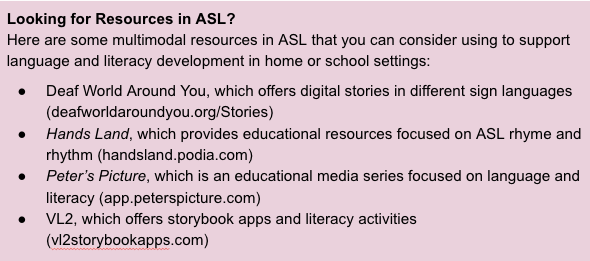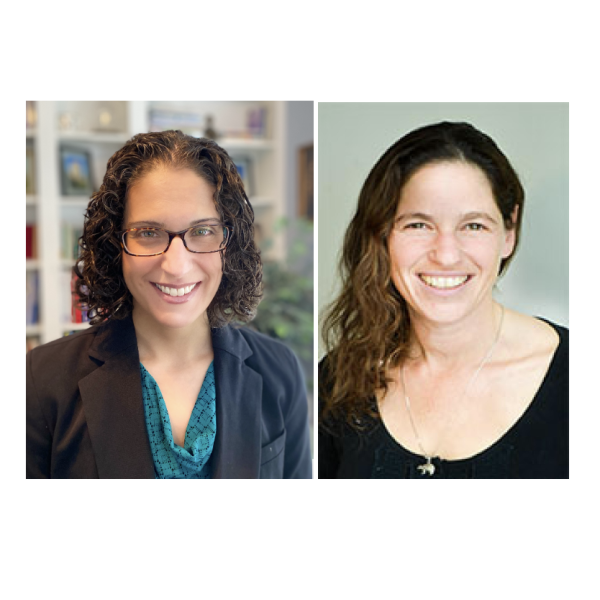Summer Reading in Children’s Preferred Language(s)
Annie Moses, Ph.D., is the Director of Periodicals / Editor in Chief at the National Association for the Education of Young Children (NAEYC). Previously, she served as an associate professor and program coordinator of early childhood, and her research focuses on early literacy, media, and early childhood education. Debbie Golos, Ph.D. is an associate professor & Deaf/Hard of Hearing licensure & MEd coordinator in the special education program at the University of Minnesota Twin Cities.
NOTE: Dr. Moses and Dr. Golos' post is in response to the introduction post, "What Should "Count" for Summer Reading" and follows Dr. Reynolds' post, "Choice and Possibility in Summer Reading", public librarian Stephanie Schott's post "What 'Counts' as Reading", and Dr. Macaluso's response. We will be sharing our final post on Thursday, 9/5.
As previous posts in this blog series highlight, for children’s summer reading, choice is a powerful thing. So is format. Based on our work over the years, we would like to add another layer to the question of what counts: Can children find summer reading in their preferred language(s)?
Like many who become literacy researchers, we have always been fascinated by how children learn to read and write. But it was during a chance encounter with Debbie that I (Annie) was confronted with a significant gap in my understanding of literacy development—I had only considered the path to reading and writing through sound and spoken language.
However, that is not the case for all children. Deaf children—particularly those with early access to a fully accessible language such as sign language—can develop in reading and writing through a visual language (e.g., Scott, 2022), such as American Sign Language in the United States. ASL (or another sign language) is a preferred language of Deaf communities. Sign language can serve as a link to English print literacy skills for Deaf children (e.g., Scott, 2022), and evidence suggests that all children can benefit from early access to ASL (e.g., Moses et al., 2015).
All children need and deserve literacy-rich environments and experiences driven by what interests them. But those without fully accessible materials and interactions face a different kind of “summer slide,” which could extend beyond summers. Research shows that Deaf children typically do not receive a solid foundation in a language during their earliest years. This, in turn, can lead to later gaps found in social, emotional, and academic development, including reading (e.g., Gulati, 2019; Hall, 2017).
There are ongoing debates about how best to promote language and literacy skills in Deaf children. Literacy strategies, activities, and materials should tap into research-informed multilingual practices, including the following:
- using Deaf children’s preferred language(s) (Kuntze et al., 2021; Kuntze et al., 2024)
- having texts that portray positive and accurate messages about Deaf people (e.g., Golos & Moses, 2013)
- incorporating multimodal texts that make connections between sign language and print (e.g., Golos & Moses, 2015; Herzig & Allen, 2023; Holcomb et al., 2022)
- Deaf people creating and modeling different genres of ASL literacy (see Motyliński et al., 2024)
As we think about what counts for children’s summer reading, we invite you to reflect on pathways to literacy. Does every child you work with have fully accessible, literacy-rich environments, materials, and interactions in their preferred language(s)? If not, what is a step you can take to support inclusive literacy experiences for them?

When choosing resources in ASL, check to see who developed the material. Was it developed and/or informed by Deaf people fluent in ASL? (For more on how to select resources for Deaf children, see Golos et al., 2021 and Moses et al., 2018.)
1. We use the term Dear here to represent Deaf and hard of Hearing children of varying hearing levels (Kuntze et al., 2024).
References
Golos, D. B., & Moses, A. M. (2013). Rethinking the portrayal of Deaf characters in children’s picture books. Frontiers in Psychology, 4, 889. https://doi.org/10.3389/fpsyg.2013.00889
Golos, D. B., & Moses, A. M. (2015). Supplementing an educational video series with video-related classroom activities and materials. Sign Language Studies, 15(2), 103-125.
Golos, D., Moses, A., Gale, E., & Berke, M. (2021). Building allies and sharing best practices: Cultural perspectives of Deaf People and ASL can benefit all. LEARNing Landscapes, 14(1), 97-110.
Gulati, S. (2019). Language deprivation syndrome. In N. Glickman & W. Hall (Eds.), Language deprivation and Deaf mental health. Routledge.
Hall, W.C. (2017). What you don’t know can hurt you: The risk of language deprivation by impairing sign language development in Deaf children. Maternity and Child Health Journal, 21, 961-965.
Herzig, M., & Allen, T.E. (2023). Deaf children’s engagement with American Sign Language-English bilingual storybook apps. The Journal of Deaf Studies and Deaf Education, 28(1), 53–67.
Holcomb, L., Golos, D., Moses, A., & Broadrick, A. (2022). Enriching Deaf children’s American Sign Language phonological awareness: A quasi-experimental study. Journal of Deaf Studies and Deaf Education, 27(1), 26–36.
Kuntze, M., & Golos, D. (2021). Revisiting rethinking literacy. In C. Enns, J. Henner & L. McQuarrie (Eds.), Discussing bilingualism in Deaf children. Routledge Taylor & Francis. New York.
Kuntze, M., Golos, D., Kurz, C., & Wolbers, K. (2024). Introduction. In D. Golos, M. Kuntze, K. Wolbers, & C. Kurz (Eds.), 58-IN-MIND: Multilingual teaching strategies for diverse Deaf students (p.1). Gallaudet Press.
Moses, A. M., Golos, D. B., & Bennett, C. M. (2015). An alternative approach to early literacy: The effects of ASL in educational media on literacy skills acquisition for hearing children. Early Childhood Education Journal, 43(6), 485–494.
Moses, A. M., Golos, D. B., & Holcomb, L. (2018). Creating and using educational media with a cultural perspective of Deaf people. Language Arts, 96(1), 67–71.
Motyliński, B., Kurz, C., & Stewart, J. (2024). ASL language arts and ASL in content areas. In D. Golos, M. Kuntze, K. Wolbers, & C. Kurz (Eds.), 58-IN-MIND: Multilingual teaching strategies for diverse Deaf students (p.1). Gallaudet Press.
Scott, J. A. (2022): Building a foundation for reading success: early American Sign Language and academic literacy outcomes among deaf and hard of hearing adolescents, International Journal of Bilingual Education and Bilingualism, 25(9), 3347–3360.
